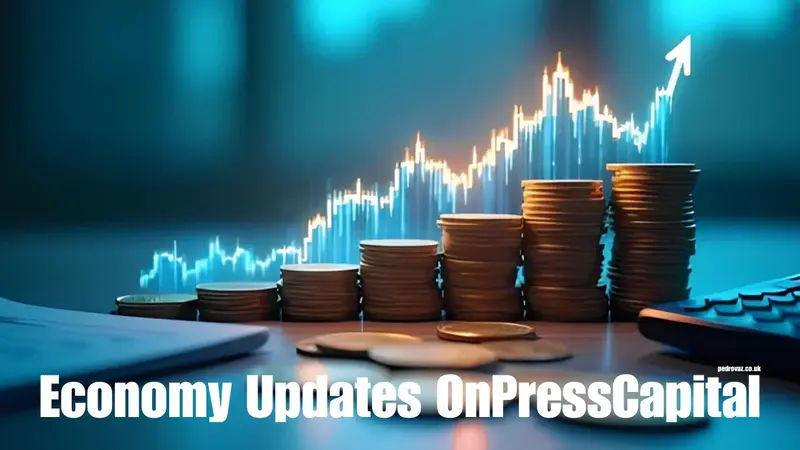The global economy is constantly evolving, influenced by factors such as technology, trade policies, political decisions, consumer behavior, and international relations. Staying updated with economic changes is essential for businesses, investors, policymakers, and individuals who wish to make informed financial decisions. This article provides a comprehensive look at the latest developments, offering insights into global shifts, regional impacts, and the broader challenges shaping the financial landscape. These economy updates onpresscapital highlight the trends driving markets and shaping future strategies.
1. Understanding the Importance of Economic Updates
Economic updates provide valuable insights into the current financial climate. By analyzing indicators such as GDP growth, unemployment rates, inflation, and investment activity, experts can assess the stability and trajectory of an economy. For businesses, such updates guide decisions about expansion, pricing strategies, and market entry. For individuals, they serve as a reference point for managing personal finances, from savings and investments to everyday budgeting.
2. Global Economic Landscape in 2025
The year 2025 marks a period of dynamic change in the global economy. Nations are adapting to post-pandemic realities, new technologies, and shifting trade patterns. Several key factors are shaping the current financial landscape:
2.1 Technological Transformation
Artificial intelligence, digital currencies, and automation are accelerating productivity but also reshaping job markets. While technology is creating new industries, it is also displacing traditional roles, raising questions about reskilling and inclusive growth.
2.2 Trade and Geopolitics
Global trade is deeply influenced by ongoing geopolitical tensions, including tariff wars and strategic alliances. Countries are diversifying supply chains to reduce dependency on single markets, which impacts both global businesses and local economies.
2.3 Energy and Climate Transition
The global push toward renewable energy and sustainable practices is reshaping investments. Green technology and eco-friendly infrastructure are emerging as strong economic drivers, supported by both private and government initiatives.
3. Regional Perspectives on Economic Growth
While the global economy moves in cycles, regional trends offer unique insights. Different regions experience growth and challenges based on demographics, policies, and resources.
3.1 North America
The United States remains a key driver of the global economy. Its innovation sector, particularly in artificial intelligence, continues to fuel growth. However, inflation and political uncertainties are influencing consumer confidence and investment strategies.
3.2 Europe
Europe faces the dual challenge of maintaining economic stability while addressing energy shortages. Policies promoting renewable energy and digitalization are helping balance growth, but rising living costs remain a concern for households.
3.3 Asia-Pacific
Asia continues to be a growth engine, led by China and India. Infrastructure development, digital transformation, and expanding middle-class markets are boosting regional progress. However, debt management and global trade restrictions remain hurdles.
3.4 Emerging Economies
Emerging markets in Africa and Latin America are experiencing steady growth due to investment in infrastructure and natural resources. Nonetheless, these regions face challenges in maintaining political stability and securing foreign investment.
4. Key Economic Indicators to Watch in 2025
Understanding economic updates requires analyzing major indicators that reflect the health of financial systems.
-
Gross Domestic Product (GDP): Measures overall economic activity and growth.
-
Inflation Rates: Show how consumer prices are changing, affecting purchasing power.
-
Employment Statistics: Indicate the strength of job markets and household income stability.
-
Interest Rates: Influence borrowing, investment, and consumer spending.
-
Stock Market Trends: Reflect investor confidence and future expectations.
These indicators serve as benchmarks for businesses and individuals when making financial decisions.
5. Challenges Facing the Global Economy
Several challenges continue to affect global growth, making it essential to monitor economy updates onpresscapital for accurate analysis.
5.1 Inflation and Rising Costs
Persistent inflation remains one of the most pressing challenges. Higher prices reduce consumer spending power, increase business costs, and strain government budgets.
5.2 Supply Chain Disruptions
Global supply chains are still recovering from the pandemic, natural disasters, and geopolitical tensions. Delays and shortages affect manufacturing, trade, and distribution.
5.3 Debt and Fiscal Management
Many governments accumulated significant debt during the pandemic, and repaying these obligations without stifling growth is a delicate balancing act.
5.4 Technological Inequality
While technology boosts productivity, unequal access creates economic gaps between developed and developing nations, as well as between urban and rural areas.
6. Opportunities in a Changing Economy
Despite challenges, economic transitions also bring opportunities for growth and innovation.
6.1 Green Economy
Investments in renewable energy, sustainable agriculture, and eco-friendly technologies are opening new industries and job opportunities.
6.2 Digital Finance
Fintech, digital currencies, and blockchain are transforming financial services, making them faster, more inclusive, and more secure.
6.3 Healthcare and Biotechnology
Global health concerns have accelerated advancements in biotechnology and healthcare infrastructure, creating new avenues for investment and development.
6.4 Emerging Consumer Markets
As middle-class populations grow in emerging economies, demand for goods, services, and digital platforms continues to rise, creating vast potential for businesses.
7. The Role of Policymakers and Institutions
Governments and financial institutions play a crucial role in stabilizing economies. By implementing fiscal policies, regulating markets, and supporting innovation, policymakers can create an environment for sustainable growth. Strong institutions ensure transparency, reduce risks, and provide support to businesses and consumers during times of uncertainty.
8. Preparing for the Future: Practical Guidelines
Individuals and businesses can adapt to economic changes by following certain principles:
-
Stay Informed: Regularly follow reliable updates on global and local financial developments.
-
Diversify Investments: Spread assets across industries and regions to minimize risks.
-
Adopt Technology: Leverage digital tools to improve efficiency and competitiveness.
-
Plan for Sustainability: Align business strategies with environmental and social goals.
-
Build Financial Resilience: Maintain emergency funds and flexible strategies to handle unexpected downturns.
9. The Human Side of Economics
Beyond numbers and policies, economic changes affect real people. Rising prices, employment shifts, and evolving industries influence families, workers, and communities. Recognizing the human side of economic shifts helps ensure that growth remains inclusive and sustainable. Balancing profit with social responsibility is essential for long-term stability.
10. Looking Ahead: What to Expect
As 2025 progresses, the global economy will continue to face both obstacles and opportunities. Innovation, sustainability, and adaptability will be the guiding principles for growth. Whether it is tackling inflation, navigating geopolitical changes, or seizing opportunities in green and digital sectors, staying updated remains the most effective strategy for success.
By consistently reviewing economy updates onpresscapital, businesses, policymakers, and individuals can prepare for uncertainties and align with trends shaping the financial future.
Conclusion
Economic updates are more than just data—they are insights that shape decisions and influence future outcomes. By understanding global and regional dynamics, key indicators, challenges, and opportunities, we gain a clearer perspective on how economies evolve. For businesses, staying ahead of trends is vital for competitiveness. For individuals, awareness helps with smarter financial planning.
In today’s interconnected world, constant monitoring of economy updates onpresscapital ensures preparedness for both risks and opportunities. The global economy may be uncertain, but knowledge remains the most reliable tool for navigating its complexities.

